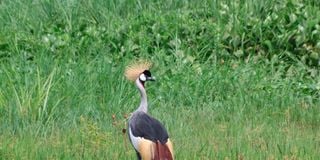Grey crowned cranes stare at extinction as wetlands shrink

A grey crowned crane at Angalo Beach in Lake Victoria, Homa Bay on February 4.
What you need to know:
- Despite calls for protection of wetlands; human settlement remains the biggest challenge. In some areas, farmers set fire to wetlands to create space for planting crops.
- Mr Nyandoro says waste disposal and other forms of pollution in wetlands are also a major threat.
The grey-crowned crane bird is threatened by humans; with habitat loss being the major issue affecting its survival. Grey-crowned cranes are mostly found in wetland areas such as swamps and marshes.
They are also common in areas around rice plantations, especially during planting and harvesting season. Most of these areas are shrinking due to climate change, which speeds up the rate of evapotranspiration, leading to reduced water levels in the wetlands and drying up of plants.
Some people have also converted wetlands into homes, displacing the birds and other organisms that are using swamps as their habitat. According to the Kenya Crane and Wetland Conservation Programme, Homa Bay is one of the counties where the bird, locally known as ongowang’, faces extinction.
Damaris Kisha, the organisation's senior field officer in charge of Homa Bay and Kisumu, says the population of the bird has been reducing over the years.
The organisation works to conserve wetlands with an aim of protecting the grey-crowned crane. However, increased human activities in its habitat make it hard for the birds to breed.
"The grey crowned crane is an endangered species and one of the leading causes is wetland degradation," says Ms Kisha says. The organisation conducted a census of the bird in 2019 and March 2023, which revealed a sharp decline.
In Homa Bay, there were at least 805 grey-crowned cranes in 2019 but this reduced to 370 in selected wetlands.
Kisumu had 350 cranes in 2019 but the number rose to 450 in 2023. Kenya Crane and Wetland Conservation Programme is currently working on a strategy to protect wetlands to save cranes in Kisumu and Migori.
The National Environment Management Authority director in Homa Bay Josiah Nyandoro says residents must join hands in conserving the shrinking wetlands to combat the adverse impacts of climate change.
Mr Nyandoro says wetlands, besides being habitats for wildlife, capture large quantities of carbon dioxide and other greenhouse gasses from the atmosphere and store them in their soil and plants, a process known as carbon sequestration. He says the areas also help in reducing soil erosion.
Despite calls for protection of wetlands; human settlement remains the biggest challenge. In some areas, farmers set fire to wetlands to create space for planting crops. Mr Nyandoro says waste disposal and other forms of pollution in wetlands are also a major threat.
Climatologist Clifford Omondi says the conservation of wetlands is one of the ways of mitigating the adversities of climate change. “We must conserve them because this will help us in mitigating the negative impact of climate change,” Mr Omondi explains.
Homa Bay County has more than 60 wetlands that are not gazetted and face imminent encroachment and pollution.
Mr Omondi calls for the gazettement of more wetlands in the county to enable the allocation of funds for conserving them.
Homa Bay County Environment Chief Officer Donald Ogweno says the devolved unit is processing the gazettement of some wetlands. "Wetlands are significant for reproduction of fish and other aquatic life in the county,” says Prof Ogweno.




